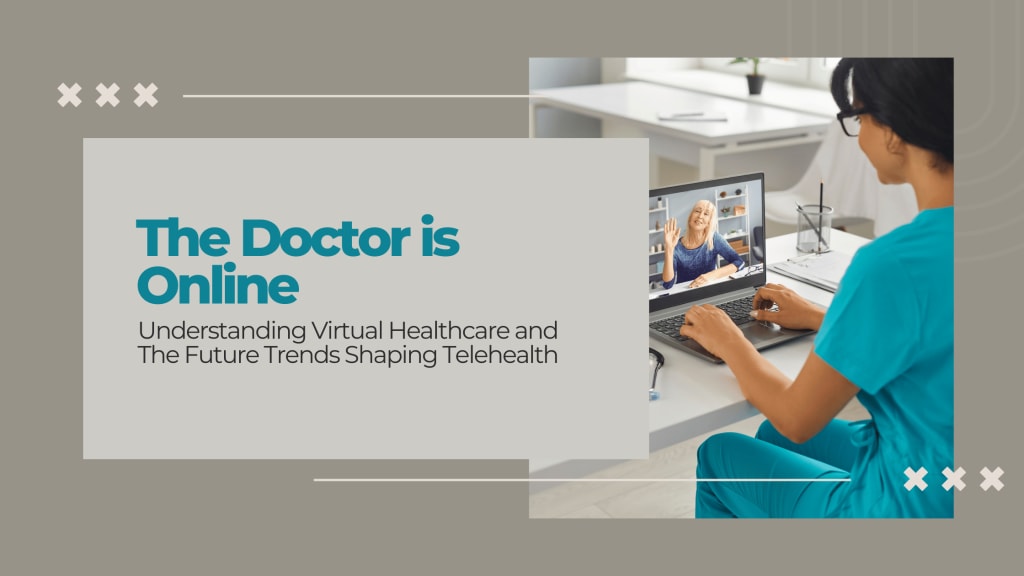The Doctor is Online
Understanding Virtual Healthcare and The Future Trends Shaping Telehealth

The COVID-19 pandemic hit the world hard, making social distancing, at least temporarily, the 'new normal'. In response to this, technological advancements sky-rocketed, especially those that enabled things to be done remotely. This was also when the healthcare sector saw a surge in technical advancements. Virtual healthcare started gaining traction and soon became acceptable across the globe. Although virtual healthcare had already started in the healthcare sector, it was after the pandemic that these facilities began to grow rapidly and become more widely available to the masses. Virtual healthcare, in simple terms, refers to a wide range of remote services within the healthcare sector that enable patients to interact with doctors and consultants remotely. In addition to this, virtual healthcare offers patients, physicians, physician assistants, and other healthcare professionals an opportunity to share information and relevant content and conduct online consultations and interactions. Telemedicine also falls into this virtual healthcare category. It primarily refers to providing patients an alternative to traditional, in-office health visits, where clinical consultations may take place between patients and healthcare providers from any locale with an internet connection instead of directly visiting the hospitals or clinics.
Telemedicine involves using telecommunications technology to provide real-time healthcare services, including services from consultants (virtually), remote monitoring of patients, and accessing telemedicine platforms. With the need for social distancing and lockdowns, the COVID-19 pandemic helped accelerate the adoption of telemedicine. In the US, the use of telehealth services increased 38 times during the pandemic (as shown in a report by McKinsey).
This rise in virtual healthcare options can be attributed to the fact that telemedicine brings several benefits to both patients and healthcare providers. One of the main benefits is that it significantly increases patient access to care, particularly for people who live in rural or otherwise underserved areas. Telemedicine enables a patient to consult with a healthcare professional remotely without the need to travel distances, saving time, lowering expenses, and increasing accessibility. Also, virtual consultations allow greater flexibility in scheduling appointments, improving patient convenience.
Telemedicine also enhances the continuity of patient care by enabling remote monitoring of patients with chronic conditions. Through wearable devices and remote monitoring platforms, healthcare providers can track patients' vitals, check whether they are taking medication as prescribed, and monitor disease progression (if any) in real time. This proactive approach to monitoring allows for early intervention and better management of chronic diseases, improving patient care and diagnosis.
Despite its benefits, telemedicine does present unique challenges that must be addressed to ensure its widespread adoption and effectiveness. One major challenge is the digital divide, where individuals with limited access to technology or internet connectivity may be excluded from virtual healthcare services. Moreover, data privacy and security concerns pose significant barriers to telemedicine adoption, as patients worry about the confidentiality of their medical information being shared or becoming easily available to unreliable resources committing fraud. Cybersecurity incidents involving healthcare organizations continue to rise, and providers and patients will need to find new ways of securing this data.
Another challenge is the potential for disparities in healthcare access and quality. While telemedicine offers greater accessibility to care for some patients, others may face challenges accessing or navigating virtual platforms, particularly older adults or individuals with limited digital literacy. Thus, providing digital literacy is important to ensure that telemedicine services are inclusive and equitable for all patient populations.
Now let's have a look at how advancements in telehealth technology are going to shape the future of healthcare:
Advancements in technology continue to drive innovation in telehealth solutions, enhancing the quality and scope of virtual healthcare services. Artificial intelligence (AI) and Machine Learning (ML) algorithms are being integrated into telemedicine platforms to support diagnostic decision-making, customize treatment plans, and improve patient outcomes. Further research is being conducted to explore the potential applications of Virtual Reality (VR) and Augmented Reality (AR) technology in improved telemedicine practices, such as virtual visits and medical training simulations.
The opportunity for the future growth of virtual healthcare services is significant, as the approach to healthcare delivery continues to be steered by technological advancements and changing patient preferences. Hybrid care that incorporates both virtual and in-person encounters will likely become more popular as telemedicine becomes more ingrained in traditional healthcare. In addition, the use of telehealth outside of primary care to include specialty care, mental health, and preventive services can address the needs of a broader patient demographic.
With ongoing advancements in telehealth technology and a focus on addressing these challenges, virtual healthcare can revolutionize how healthcare is delivered and experienced, ultimately improving patient outcomes and population health.
About the Creator
Bryan Long
Bryan Long is a technology, healthcare, and finance professional. He is based in Arizona and is the CFO of Signature Dental Partners. Visit BryanLongArizona.org.
Enjoyed the story? Support the Creator.
Subscribe for free to receive all their stories in your feed. You could also pledge your support or give them a one-off tip, letting them know you appreciate their work.






Comments
There are no comments for this story
Be the first to respond and start the conversation.